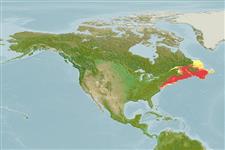| Native range | Point map | Year 2100 |

|
| Limanda ferruginea AquaMaps Data sources: GBIF OBIS |
Length at first maturity
Lm 29.8 range ? - ? cm
Uso pelos humanos
Pescarias: espécies comerciais; Aquacultura: experimental
Phylogenetic diversity index
(Ref. 82805)
PD50 = 0.5156 many relatives (e.g. carps) 0.5 - 2.0 few relatives (e.g. lungfishes)
Nível Trófico
(Ref. 69278)
3.3 ±0.1 se; Based on diet studies.
Resiliência
(Ref. 69278)
Médio, tempo mínimo de duplicação da população 1,4 - 4,4 anos (rm=0.69; K=0.3; tm=2-6; tmax=12)